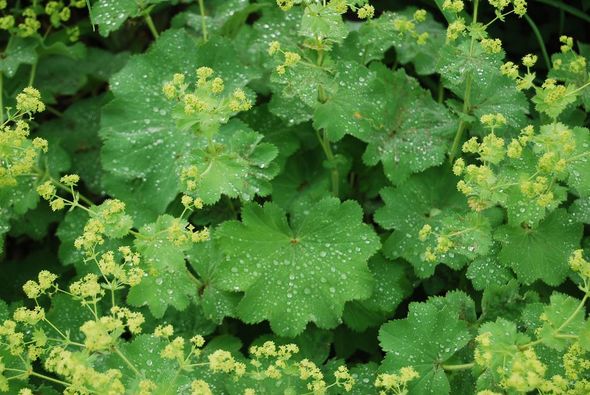Lady's Mantle (Alchemilla MoLlis)
|
Lady's Mantle (Alchemilla Mollis)
Common names: Lady's Mantle Benefits to Wildlife: Attracts Butterflies Genus: Alchemilla Family: Rosaceae Species: a.mollis Type: Herbaceous Perennial Hardiness: Zones 3 - 8 Bloom Time: Early-mid summer Exposure: Full Sun or Partial Shade Height: 12" - 18" Spread: 18-23 inches Description: Plants form a mound of rounded, velvety soft olive-green leaves, which catch and hold water drops, then sparkle in the sun. Leaves are palmately veined, with a scalloped and serrated margin. The stipules are noteworthy in that they are fused together and leaf like. The chartreuse yellow flowers are held in dense clusters above the foliage. Dwarf varieties are also available. Cultivation: Plants should be sheared back after blooming to rejuvenate the leaves and generally tidy the clumps up for the remainder of the growing season. Fertilizing: Soil: Normal, sandy or clay pH: Neutral, alkaline or acid Watering: Not drought tolerant. Water when dry. Pests/Diseases: No serious insect or disease problems. Reflowering: Prompt removal of spent flower stems will not only prevent self-seeding but may also encourage a sparse, late summer rebloom. Propogation/Transplanting: Plants may be grown from seed started indoors about 6-8 weeks prior to last spring frost date.May be divided in spring or early fall. The plant self-seeds freely and can become invasive. Notes/Gardening Tips: Easily grown in average, medium moisture, well-drained soils in full sun to part shade, but tolerates close to full shade. Prefers part afternoon shade in hot summer climates. Performs well in moist garden areas. Alchemilla mollis, is native to southern Europe and grown throughout the world as an ornamental garden plant. It is the most commonly planted of nearly 300 species in the genus in the rose family (Rosaceae) native to the mountains of Europe, Asia, and North America. Its common name supposedly comes from the resemblance of its scalloped leaves to the Virgin Mary’s cloak, although other explanations exist. Native to Turkey and the Carpathian Mountains, A. mollis has been used medicinally for stomach ailments and to dye wool green. It has sometimes been confused with two other species that have a history of medicinal use: A. alpina (alpine lady's mantle) and A. xanthoclora. The dense hairs on the leaves catch and hold water droplets, so are very attractive after a rain or in the morning when drops of dew collect on the textured leaves like a sprinkling of diamonds or beads of liquid mercury. These beads of water were considered by alchemists to be the purest form of water, and they used this water when attempting to turn base metal into gold – hence the name “Alchemilla”. Often used as edging, ground cover or as a cut flower. |

